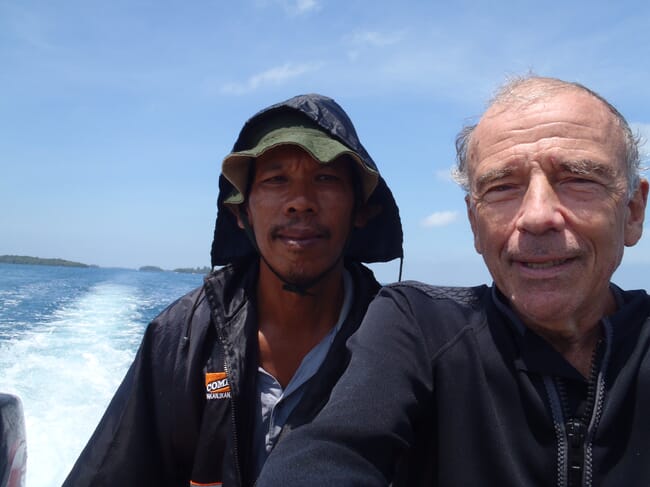This is achieved through the upregulation of the heat shock proteins (HSPs) with chaperone and immunomodulatory roles functioning in networks.
Many supporting data are available in recent scientific literature, and hyperthermia treatment is increasingly used also in human cancer therapy. Aquatic organisms are living in a world full of viruses, bacteria and parasites – some of which are very harmful. In aquaculture the critical point is the production of fast growing and healthy juveniles in nursery systems. It requires a domesticated broodstock under a selective breeding programme and juveniles equipped to enter the grow-out systems safely.

After retiring from IFREMER Alain Michel (right), helped to develop an offshore farm near a small island of the Java Sea, producing barramundi, snapper, grouper, cobia and pomfret.
The present dominant paradigm is to consider the pathogens as devils and to do everything to eradicate them: pathogens are “personae non grata” in hatchery and nursery systems. Strict biosecurity is the prevailing strategy, aiming at eradicating all the potential pathogens through sophisticated water treatment, tight control of all the inputs and use of various functional feeds.
Modern hatcheries produce pathogen-free juveniles equipped, through vaccination, to cope with the main pathogens. Without vaccination these fish are naive and when they encounter local pathogens for the first time in grow-out systems large outbreaks of mortalities often occur.
Over the last 50 years intensive research projects on vaccine development have been conducted and for a mature industry like salmon culture all the main pathogens have their vaccines – of either the killed, attenuated, or recombinant variety. Oral vaccines are not common and juveniles of many species have to be injected individually, which is labour intensive. The cost of developing and licensing new vaccines is high and for low market value species like catfish or tilapia they are often too expensive for commercial purposes.
Live vaccines tend to be more immunogenic in entering the host and stimulating cellular responses, linked to both innate and adaptive immunity.
A paradigm shift
What I am proposing is to directly use the pathogens at the moment when they are invading the hosts to obtain the vaccination effect, not in reducing the virulence of the pathogens but in boosting the hosts’ innate immune system response, which will immediately stop mortalities and will transfer to the adaptive immune system the memory of the first encounter. This can be done with each pathogen one by one, but is better with a mix of pathogens that mirrors the local pathobiome and gives long-term protection.
Instead of a reductionist approach, in which pathogens are considered as our enemies, it is better to live with them, recognising they are an integral part of our environment and will be always there. We can enrol them on our side to obtain the “live vaccination effect” and recognise that their specific effect is mainly imbedded in their interrelations of all the components of the pathobiome with the host at a given moment and in a given environment. What I am proposing is to use a holistic approach considering the pathobiome as the main player attacking the fish. Instead of weakening the pathogens we should expose the juveniles to their full immunogenicity, resulting in long-term protection.
This is immunotherapy in real time and if evolution has conserved the heat shock protein response from bacterial to human cells as the first line of defence it is evidence of their pivotal role. Practically it starts by a controlled infection of the juveniles using the pathobiome found in the on-growing environment, followed by non-lethal heat shock treatments to create immunisation. This proposal of paradigm change is supported by all the results obtained over the last 15 years, mainly relating to pathogens impacting fish such as barramundi, tilapia, grouper and snapper, as well as some promising results with invertebrates like shrimp and oysters.
As is common with the introduction of such an innovative approach, I expect there will be negative reactions.
Initially many people may dismiss it as a ridiculous concept: but I am eager to hear and discuss the arguments. Others might claim that it is too dangerous: I’m fully conscious that to voluntarily infect juveniles is against politically correct biosecurity dogma, but it is more effective in the long-term. And in the long-term I think that the benefits of the system will become evident to the farmers.
Trials have already shown that thermal manipulation can help to protect barramundi, groupers and other tropical species against VNN, Iridovirus, ISKNV, SDD virus and herpesvirus, as well as emerging iridovirus on tilapia in Ghana.
For a number of species juveniles are now often kept in nurseries for longer before transfer to cages, but once immunised at small sizes they could be transferred around 10-15 g, thereby tremendously increasing juvenile production levels.
All critiques and comments are welcome and I am on standby on the internet to help anyone who would like to run some trials to define the best protocol for their system and species. I can be reached at alainhenri@aol.com




